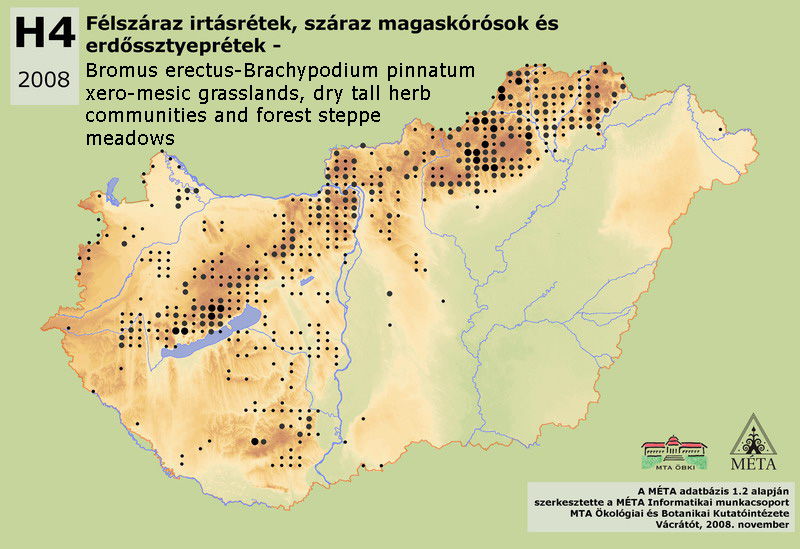MÉTA Program >>> Élőhelyek elterjedési térképei


H4 - Félszáraz irtásrétek, száraz magaskórósok és erdőssztyeprétek:
Főleg széleslevelű pázsitfüvek által uralt, eltérő származású és fajösszetételű, fajokban, így kétszikűekben is gazdag, erdei maradványokat is hordozó félszáraz irtásrétek, gyepek, esetleg magaskórósok. Állományalkotó füvei általában a sudár rozsnok (Bromus erectus) és a tollas szálkaperje (Brachypodium pinnatum), ritkábban a franciaperje (Arrhenatherum elatius), a magyar rozsnok (Bromus pannonicus), a hosszúlevelű árvalányhaj (Stipa tirsa) és a fogtekercs (Sieglingia (Danthonia) alpina). Jelenlegi kiterjedése mintegy 12 000 ha, ennek kétharmada az Északi-középhegységben található (8000 ha). Sokfelé, de összességében jóval kisebb kiterjedésben (2700 ha) jelenik meg a Dunántúli-középhegységben. Szórványos a Dél-Dunántúl keleti (700 ha), a Nyugat-Dunántúl északi (280 ha) és az Alföld nyugati részén (Mezőföld, 300 ha). Kis mennyiségben megtalálható még a Kisalföldön, a Dél-Dunántúl nyugati és a Duna-Tisza köze északi részén. Elsősorban hegy-dombvidéki élőhelytípus, síkvidéken csak ritkán jelenik meg. Száraz, gyakran szubkontinentális klímahatás alatt álló, erdőssztyep klímájú területeinkre jellemző leginkább. Hiányzik ugyanakkor hazánk legszárazabb részéről, az Alföld belsejéből – ez azonban részben tájhasználati okokra vezethető vissza (beszántás). Viszonylag jól felismerhető élőhelytípus, de egyéb száraz gyepektől [H3a – köves talajú lejtőgyepek, H5a - löszgyepek], olykor egyes réttípusoktól [E1 – Franciaperjés rétek] történő elválasztása helyenként nem tűnik problémamentesnek.
H4 – Bromus erectus-Brachypodium pinnatum xero-mesic grasslands, dry tall herb communities and forest steppe meadows:
Xero-mesic clearings, grasslands, sometimes tall herb communities belong to this habitat type with variable origin and species pool. These grasslands are dominated mainly by grasses of broad leaves, such as Bromus erectus and Brachypodium pinnatum, more infrequently Arrhenatherum elatius, Bromus pannonicus, Stipa tirsa, Sieglingia (Danthonia) alpina. This habitat is rich in species, also in forbs, and holds forest remnant forest species. The actual extension is 12 000 ha, the two-third of that can be found in the Északi-középhegység (8000 ha). It occurs in several places, but with much smaller area (2700 ha) in the Dunántúli-középhegység, and sporadically in the eastern part of Dunántúli-dombság (700 ha), northern part of Nyugat-Dunántúl (280 ha), and in the western part of Alföld (Mezőföld, 300 ha). It can be found in small amount also on Kisalföld, in the western part of Dunántúli-dombság, and in the northern part of the Duna-Tisza köze. It is mainly a colline habitat type, which is rare in the lowlands, occurring most typically in regions of dry, forest steppe climate, often under subcontinental influence. Whereas it is absent from Alföld, which is the driest part of the country – but this can be explained, at least partially, by the land-use history of lowland steppe landscapes (ploughing all the areas suitable for agriculture). It is relatively easy to identify this habitat, but sometimes the separation from other dry steppes (H3a, H5a), or from certain meadow types (E1) can be problematic.
Molnár, Zs., M. Biró, J. Bölöni & F. Horváth (2008): Distribution of the (semi-)natural habitats in Hungary I.: Marshes and grasslands, Acta Botanica Hungarica 50 (Suppl): 59-105. >>> letöltés (5,4 MB, PDF)
MÉTA Program,
MÉTA Fotótár
MÉTA Élőhely-Ismereti Útmutató (ÉIÚ),
MÉTA Adatlap-Kitöltési Útmutató (AL-KÚ)
(C) MÉTA Informatika, 2005-2009,
MTA Ökológiai és Botanikai Kutatóintézete